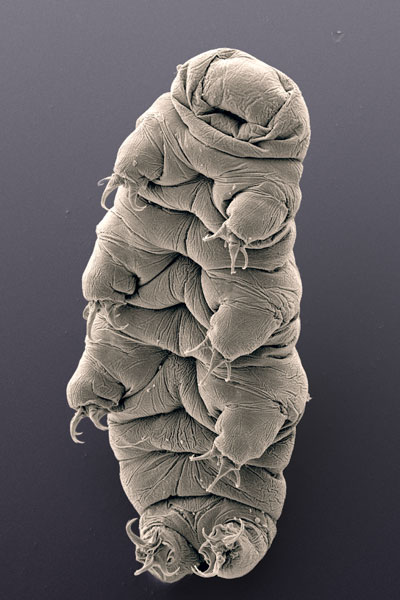
Image by Bob Goldstein and Vicky Madden Via Wikimedia Commons
There are adorable super beings hiding in the dirt. Nearly indestructible tardigrades (Latin for “slow stepper”, pronounced TAR-dee-grade) commonly known as water bears [1]. Less than a millimeter long, their pudgy bodies are made up of only 40,000 cells. They have 4 pairs of legs each ending in tiny claws and a pronged sucker for a mouth [2]. Isn’t it cute?
These little guys can thrive anywhere: hot springs, deep water trenches, even the Antarctic [1]. Their ability to adapt to any environment has made scientists curious. How much can water bears handle? What are their limits?
So far we know that water bears can survive in sub-freezing and boiling temperatures (from -272°C (-458°F) to 149°C (300°F))[3]. They can also survive for years without water and they’re also resistant to radiation, surviving levels 100 times the lethal dose for humans [4].
They can even survive in the vacuum of space. In 2007, thousands of water bears were launched into orbit and exposed to the vacuum of space for 10 days. After returning to Earth, researchers found that 68% of the water bears survived [4]. Some of the females had even laid eggs while in space and the space-laid young hatched perfectly healthy. This makes tardigrades the only animal to have ever survived the vacuum of space.

We’re still not sure how water bears manage to be so indestructible, but a recent study points to a sort of natural genetic engineering.
In an earlier post, I described how genetic engineering lets scientists insert a gene from one organism (like the gene for human insulin) into another organism (like bacteria). Scientists thought they were clever trading genes between different species, but apparently this has been happening naturally for millions of years, in a process called horizontal gene transfer.
The most well-known example of horizontal gene transfer is antibiotic resistance in bacteria. Different species of bacteria regularly trade small bits of DNA. If one strain of bacteria develops resistance to an antibiotic, it can transfer that gene to a completely different species. This transfer of useful genes can happen between almost any species. Even humans have even collected a few genes from simpler organisms like bacteria [5].
A genomics lab at the University of North Carolina sequenced the water bear genome and found that 17.5 percent its DNA had come from horizontal gene transfer, higher than any known organism [2]. This DNA was foreign – it didn’t fit the pattern of the rest of the water bear’s genome. Instead they matched genes found in bacteria, plants, and fungi [6}. The lab guessed that this might explain the water bear’s extreme adaptability. It was stealing genes from other organisms in the environment, organisms that had already developed genes to adapt to extreme conditions.
Water bears engineering themselves to be indestructible would be pretty amazing, but the story doesn’t end there. Another lab in Edinburgh has called the study from UNC into question [7]. The Edinburgh lab also sequenced the water bear’s genome, but found that foreign DNA accounted for only 2% of the water bear’s genome, a percentage common among many other less impressive organisms (humans have less than 1%) [5, 8].
The Edinburgh lab argues that the UNC study may have accidentally counted contaminating DNA as part of the water bear’s genome. Water bears live in dirt, so bacteria, bits of plants, and fungi were probably collected along with the water bears and combined into one DNA sample. Because DNA from a water bear or a plant all looks alike, it’s hard to identify its source. The Edinburgh lab used a technique that identified rare genes and eliminated them as probable contamination [8]. They identified far fewer transferred genes, which means water bears may not adapt to their environment by stealing genes from other organisms.
This back and forth in science is common. Many independent labs working on the same problem cross-check each other’s results to eliminate errors. Science is constantly checking and rechecking itself. It’s only after years of independent studies that a consensus is finally reached, but at any time new research can up-end even established scientific principles.
It also means the indestructible water bear is still an adorable little mystery.
References
[1] “The Tardigrade: Practically Invisible, Indestructible ‘Water Bears'”. The NY Times. 7 September 2015.
[2] “Water Bears: Genome Sequence Says It Has Most Foreign DNA Of Any Animal”. Nature World News. 26 November 2015.
[3] “Absurd Creature of the Week: The Incredible Critter That’s Tough Enough to Survive in Space”. Wired. 21 March 2014.
[4] “Tardigrades Return from the Dead”. BBC. 13 March 2015.
[5] “Humans may harbor more than 100 genes from other organisms”. Sciencemag. 12 March 2015.
[6] Boothby, T.; Tenlen, J.; Smith, F.; Wang, J.; Patanella, K.; Osborne Nishimura, E.; Tintori, S.; Li, Q.; Jones, C.; Yandell, M.; Messina, D.; Glasscock, J.; Goldstein, B. (2015). “Evidence for extensive horizontal gene transfer from the draft genome of a tardigrade”. Proc Natl Acad Sci Nov 23: pii: 201510461. PMID 26598659.
[7] “Rival Scientists Cast Doubt Upon Recent Discovery About Invincible Animals”. The Atlantic. 4 December 2015.
[8] The genome of the tardigrade Hypsibius dujardini”. bioRxiv: